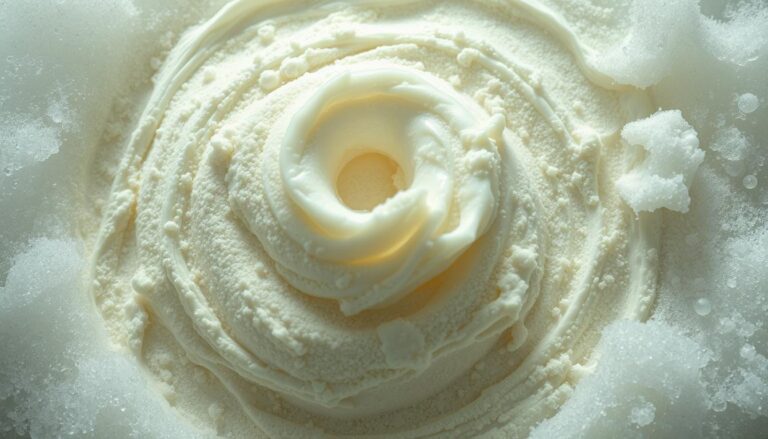Do Cleanings Whiten Teeth or Eliminate Stains?
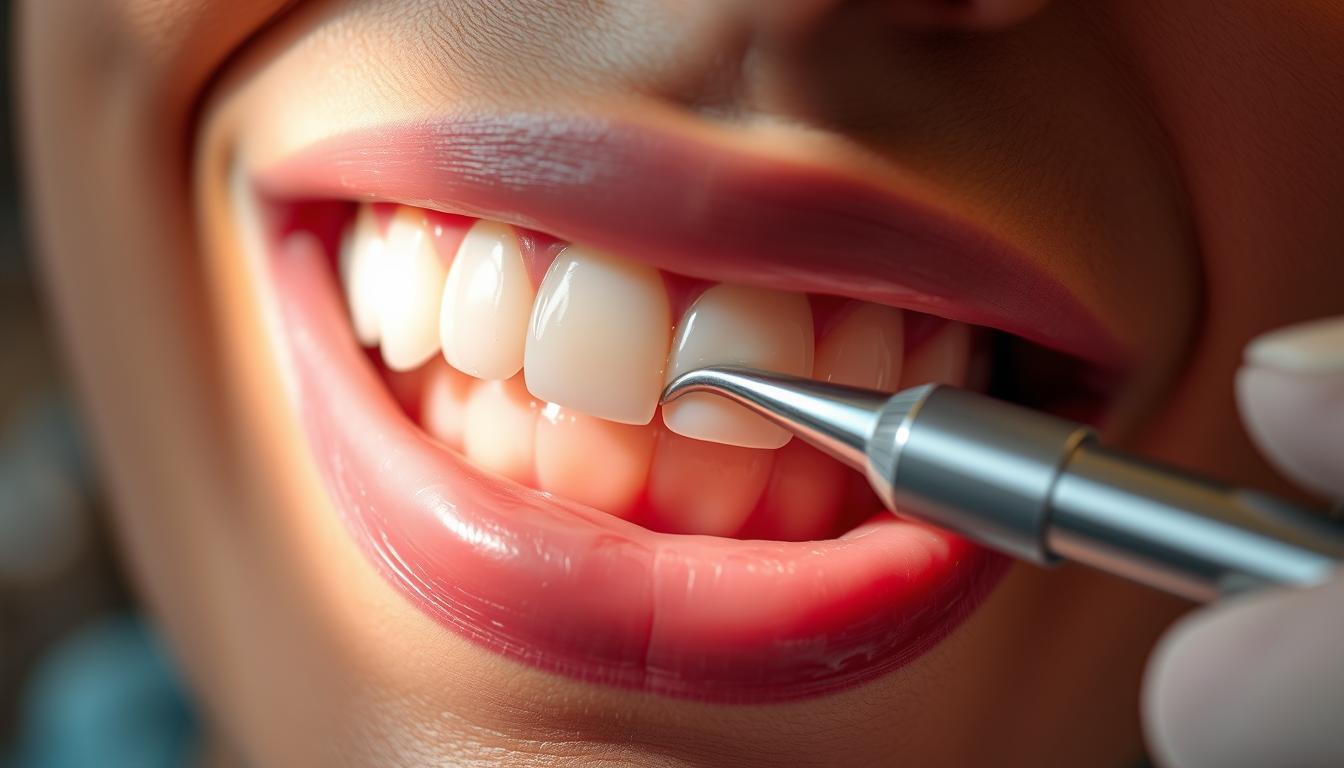
Seventy-four percent of Americans value a bright smile as a significant social asset. Yet the question remains: Can cleanings whiten my teeth or remove stains? Professional teeth cleanings are key to oral health. But keeping teeth white often needs more than a semi-annual cleaning. Dental cleanings remove plaque and tartar and may polish away some stains.
To truly brighten your smile and remove deep stains, we need to look beyond regular cleanings. Treatments specifically for teeth whitening are necessary for that extra shine.
Teeth cleaning is a great way to prevent future stains and dental problems. For that radiant smile, exploring professional whitening can make a big difference. Still, don’t overlook the value of routine cleanings. They’re the foundation for a healthy, bright smile.
Key Takeaways
- Professional dental cleanings can remove some fresh surface stains but are not primarily designed for teeth whitening.
- Achieving a whiter smile generally requires specialized teeth cleaning and whitening procedures beyond routine cleanings.
- Regular dental cleanings for stain removal play an essential role in maintaining oral health and can contribute to a brighter smile.
- It’s important to consult a dental professional to understand the most effective options for teeth whitening based on specific needs.
- Maintaining good oral hygiene practices post-cleaning can sustain a cleaner, stain-resistant dental appearance.
Understanding Teeth Cleanings and Their Purpose
Teeth cleanings are key for keeping your mouth healthy and making your smile look better. They focus on stopping dental problems by getting rid of plaque and tartar. This helps avoid gum diseases and keeps your teeth healthy for a long time.
Some people might not think teeth cleanings are as important as other dental work. But, getting your teeth cleaned regularly can make them look and feel better. It’s a big part of keeping your mouth healthy.
What is a Dental Cleaning?
A dental cleaning is done by expert dental hygienists to stop and fight gum disease. It removes plaque and tartar from your teeth and gums. This is crucial for keeping your mouth free of harmful bacteria.
Components of a Typical Cleaning
A dental cleaning includes a few important steps to clean and protect your mouth. It involves scaling to take away tartar, polishing to lessen stains, and fluoride treatments to strengthen your teeth. These steps make sure you get a deep clean.
Frequency of Dental Cleanings
Experts say you should get a dental cleaning every six months for the best oral health. Depending on your own mouth’s needs, this timing might change. Having cleanings done regularly is a smart way to keep your teeth healthy and avoid dental issues.
| Benefits | Description | Frequency |
|---|---|---|
| Plaque and Tartar Removal | Targeted removal using specialized tools | Every 6 months |
| Gum Disease Prevention | Reduces the risk of gingivitis and periodontitis | As advised by dentist |
| Fresher Breath | Eliminates bacteria that cause odors | Regular intervals |
| Improved Dental Appearance | Minor stain removal through polishing | During every cleaning session |
Knowing about the professional teeth cleaning process helps people take care of their dental health. Regular cleanings have many long-term teeth cleaning benefits.
The Science Behind Tooth Discoloration
To really get why teeth cleaning makes your smile brighter, we need to look at why teeth change color. Many things, both inside and out, make our teeth less white. Knowing these helps dentists decide how to treat them.
Common Causes of Tooth Stains
What we do every day can stain our teeth. Drinking coffee, tea, and red wine, or smoking, can darken teeth. These actions leave stains on the enamel, the outer part of our teeth. Luckily, dental cleanings can often remove these stains.
Types of Tooth Discoloration
Stains on the outside of the teeth aren’t the only problem. Inside the tooth, we can have stains too. These internal stains can come from getting older, injuries, or certain medicines when teeth are forming. They affect the dentin, inside the teeth.
Role of Enamel in Tooth Color
The enamel’s thickness matters a lot to the color we see. If the enamel is thin, the dark dentin shows more. This makes the teeth look darker. While cleaning can remove surface stains, it does not lighten the dentin inside.
The Whitening Effect of Professional Cleanings
Professional dental cleanings are crucial for keeping teeth healthy. They also make teeth look whiter by removing surface stains. These cleanings use special techniques like scaling and polishing. They focus on plaque and tartar, which can make teeth look discolored.
The success of teeth cleaning results in making teeth whiter depends on the type of stains and the teeth’s original color. If you want a brighter smile, it’s essential to know what dental cleaning for whitening can and cannot do.
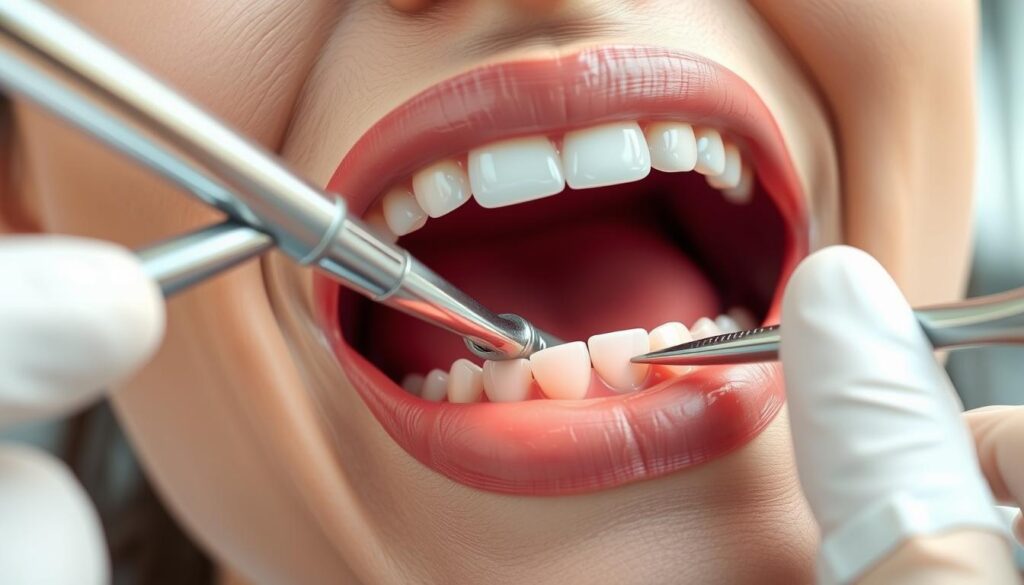
How Cleanings Remove Surface Stains
Scaling and polishing are methods used in dental cleanings to remove stains from things like food, drinks, and smoking. This process brings back the teeth’s natural color. It does this by getting rid of the stuff that causes surface stains.
Limitations of Cleanings for Whitening
Even though dental cleanings are great for getting rid of surface stains, they can’t change the teeth’s deep color. They are not the same as whitening treatments that can go deep into the enamel. Those treatments can change the natural color of teeth.
Studies on Cleanings and Whitening
- Research shows that cleanings can make teeth a bit whiter, but for big changes, you need special whitening treatments.
- Studies find that teeth often look somewhat whiter after a cleaning.
- Long-term research shows regular cleanings help keep teeth’s natural color for a longer time. They prevent more stains from forming.
In summary, professional dental cleanings are vital for good mouth health and can slightly whiten teeth by removing surface stains. But they are not a total solution for whitening. For major whitening results, talk to a dentist about specific whitening treatments.
Comparing Dental Cleanings to Whitening Treatments
Dental cleanings and teeth whitening have different goals for your smile. They focus on various aspects to ensure your teeth stay healthy and look good. This section compares the two, explaining processes, costs, and how long they last. This info helps you make the best choice for your teeth.
Different Types of Whitening Options
Whitening treatments use chemicals like carbamide peroxide to brighten your smile from the inside out. They tackle stains deep in your teeth, beyond what regular cleaning does. Other options include light-activated and laser treatments for quick results. But regular cleanings remove surface stains and tartar, aiming for health over looks.
Cost of Cleanings vs. Whitening Treatments
Dental cleanings are usually cheaper and often covered by insurance. Whitening treatments cost more since they’re seen as cosmetic. Yet, investing in both can make a big difference in your smile’s appearance and health.
Duration of Results: Cleanings vs. Whitening
Professional whitening can keep your teeth bright for months to years, depending on your care routine. Dental cleanings should happen every six months to fight plaque and keep your mouth healthy. This prevents bigger health issues down the line.
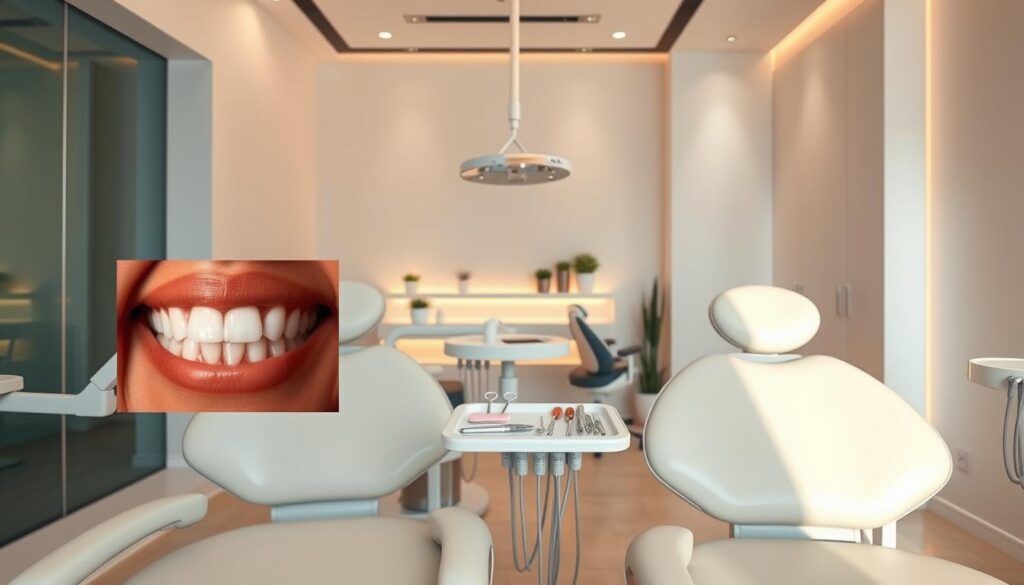
| Treatment Type | Primary Focus | Average Cost | Duration of Results |
|---|---|---|---|
| Professional Teeth Cleaning | Health (Plaque and Tartar Removal) | $75 – $200 | 6 Months |
| Teeth Whitening | Cosmetic (Stain Reduction) | $300 – $800 | 1 – 3 Years |
Impact of Cleaning Techniques on Teeth Stains
The way we clean teeth has a big effect on removing stains. Different cleaning methods offer special benefits. Knowing how each method works can make your oral care better.
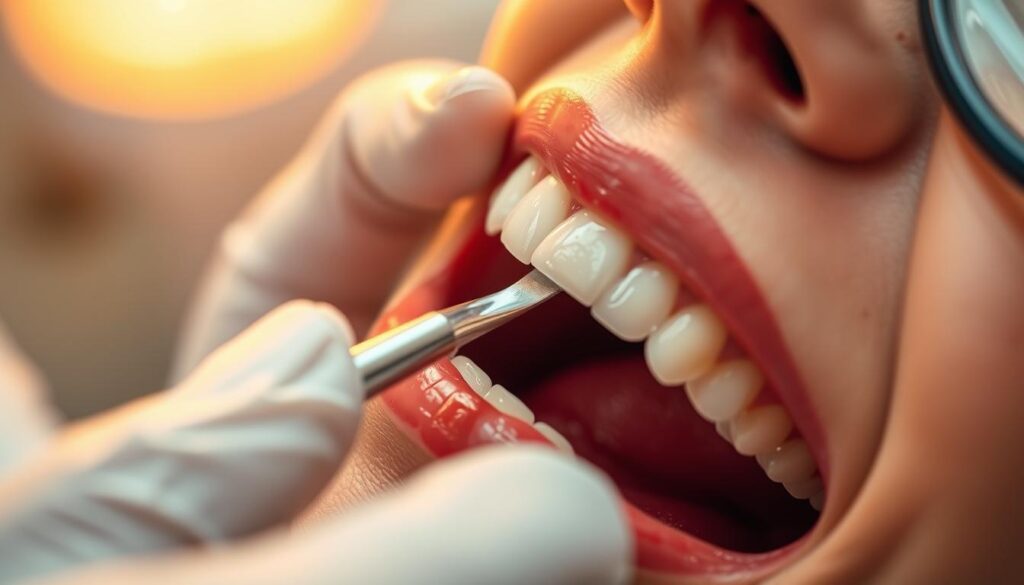
Manual Scaling vs. Ultrasonic Cleanings: Manual scaling uses special tools to scrape tartar off. It’s great at removing tough deposits and can be adjusted for each person. Ultrasonic cleaning uses vibrations to break down tartar and stains. It’s quicker and more comfy for the patient.
Role of Polish in Stain Removal: Polishing is key in teeth cleaning. It smooths teeth, removes stains, and helps prevent new ones. This improves the look and health of your teeth.
Importance of Technique and Skill: The skill of the dental professional is crucial. They use a mix of methods designed for the patient’s specific needs. This ensures the cleaning is effective and safe.
Using both old and new cleaning techniques gives the best results. It shows why seeing a dentist regularly is important for your teeth’s health and look.
Maintenance After Dental Cleanings
After getting a teeth cleaning for a brighter smile, it’s key to keep those results. Don’t just count on the cleaning itself. Take steps at home to keep your smile shining. This advice can help you keep your teeth looking great.
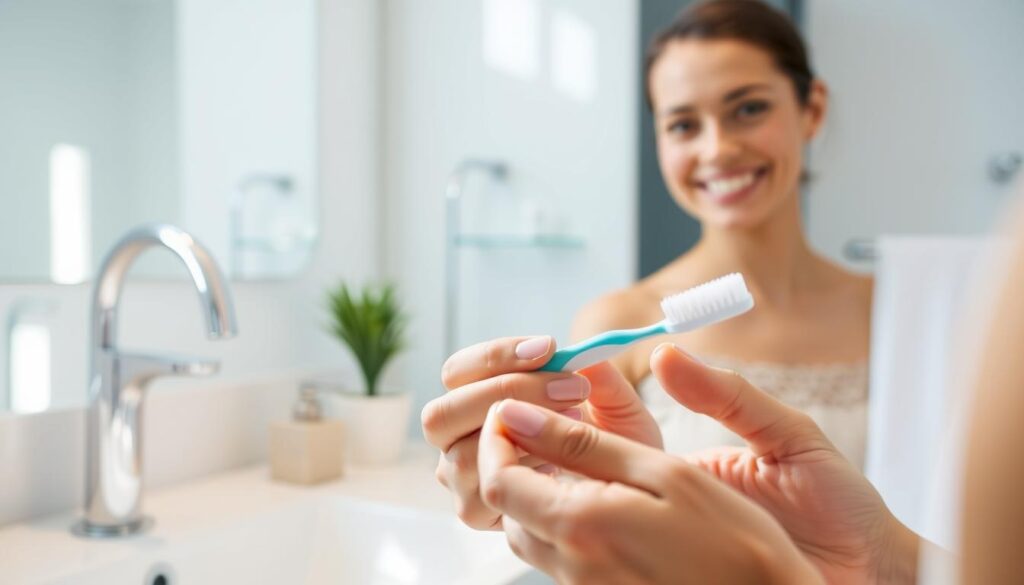
To keep your smile bright after the dentist, focus on home care and what you eat. Let’s dive into these tips:
| Tips to Keep Teeth White | Foods and Drinks to Avoid | At-Home Care Between Cleanings |
|---|---|---|
| Brush twice daily with fluoride toothpaste | Reduce intake of coffee, tea, and red wine | Regular dental checkups and touch-up treatments |
| Use whitening toothpaste | Avoid tobacco products | Daily flossing |
| Drink staining beverages through a straw | Limit berries and soy sauce consumption | Occasional use of over-the-counter whitening kits |
Seeing your dentist regularly is key to keeping your smile bright. Talking about what to expect during dental check-ups helps keep your mouth healthy and looking good. Following your dentist’s advice can make your cleaning last longer.
How you take care of your teeth at home matters as much as professional cleaning. Keeping up with these habits keeps your teeth healthy and your smile bright. It helps your overall mouth health last longer.
Staining and Oral Hygiene Habits
Keeping your mouth clean is key to prevent teeth from staining and make teeth cleaning and whitening last longer. Doing oral care routines well supports your mouth’s health. This also cuts down the need for many professional teeth cleanings.
Importance of Oral Hygiene
Good oral hygiene stops dental problems that can stain teeth. Brushing and flossing regularly stops plaque from turning into tartar. Tartar not only makes teeth yellow but can also cause gum disease.
Best Practices for Teeth Care
There are key steps to take care of your teeth every day. Brush twice a day with fluoride toothpaste, floss daily, and rinse with mouthwash. These steps keep your teeth healthy. Getting your teeth cleaned by a dentist also helps remove stains and polish your teeth.
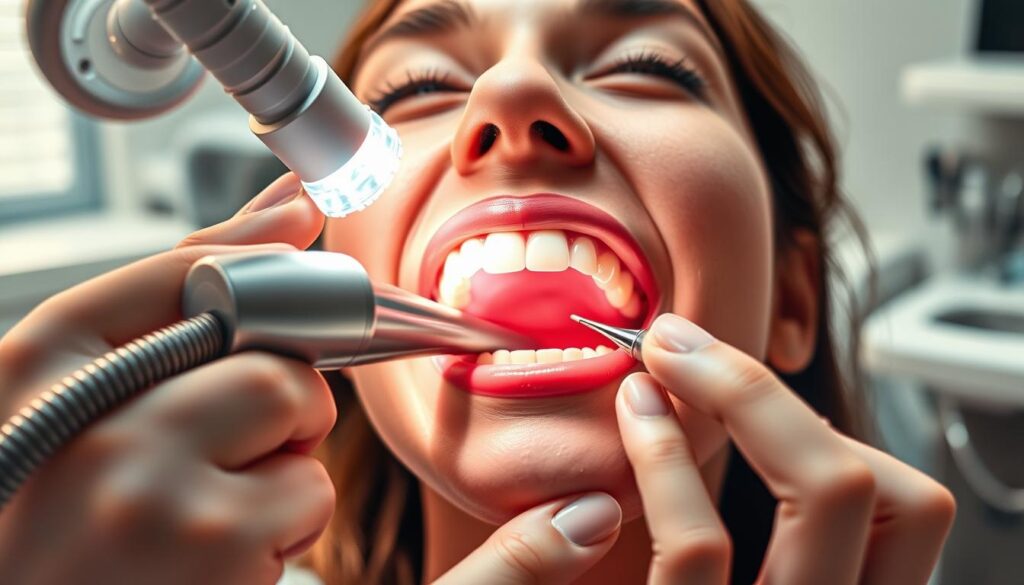
Regular Check-Ups and Their Benefits
Going to the dentist often helps catch tooth decay, gum disease, and other problems early. These visits let dentists clean and whiten your teeth well with special tools. This makes your teeth look better and healthier.
| Practice | Benefits |
|---|---|
| Brushing Twice Daily | Removes food particles and reduces plaque |
| Daily Flossing | Cleans hard-to-reach areas between teeth |
| Regular Dental Check-Ups | Early detection and treatment of oral problems |
Following these steps helps your mouth’s health. It also makes teeth cleanings more effective. This keeps your smile beautiful and healthy.
The Role of Lifestyle Choices
Lifestyle choices are crucial for the health of our teeth, impacting their color and vulnerability to stains. Knowing how our habits affect us highlights the need for regular teeth cleaning. This helps keep our teeth looking good and healthy.
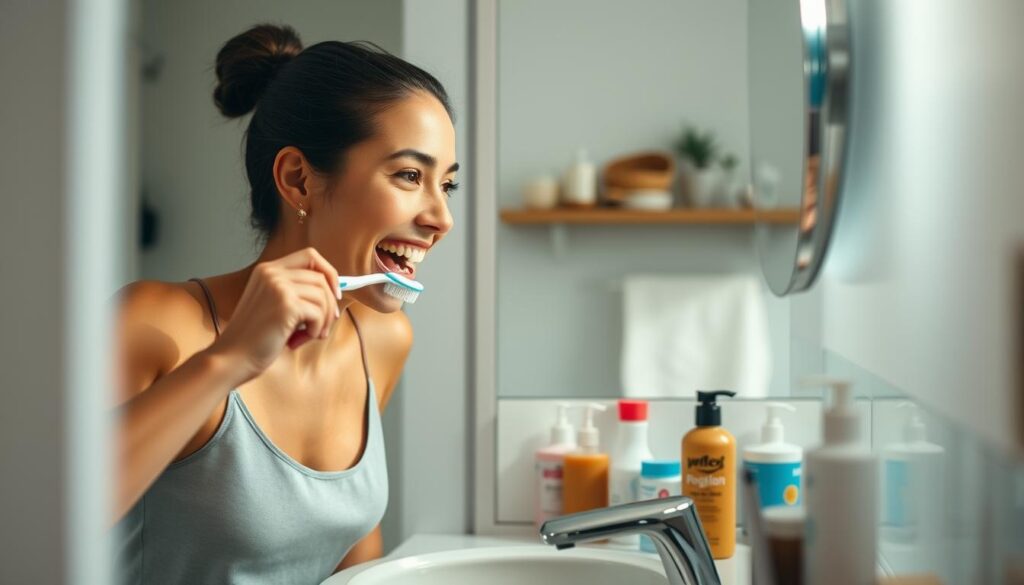
- Smoking and Teeth Staining: Smoking leads to teeth discoloration, with nicotine and tar turning teeth yellow or brown. Regular teeth cleanings can partially remove these stains, improving appearance.
- Impact of Diet on Teeth Color: The food you eat affects your teeth’s color. Soy sauce, berries, and curry can stain teeth. Routine dental care, including stain removal, is vital for those eating these foods often.
- Staining from Beverages: Drinks like coffee, tea, and red wine have pigments that stain teeth. Drinking these means you might need teeth cleaning more often to keep your smile bright.
To lessen teeth stains and get the most from cleaning, rinse with water after eating or drinking staining substances. Use a straw when you can, and stick to regular teeth cleanings. This method helps remove stains and boosts overall oral health and looks.
Professional Advice on Whitening
Thinking about making your smile brighter with teeth cleaning? Getting advice from a dentist is key. They ensure the whitening procedures are safe for you. Professional teeth cleaning not only makes your smile look better but also keeps your mouth healthy.
Dentists have the inside scoop on what will work best for your teeth. They can suggest everything from professional bleaching to special kits for home use. These are all to boost the effects of regular teeth cleanings.
Before jumping into teeth whitening, talk to your dentist. This ensures you get the safest, most fitting treatment for you.
Knowing what results to expect is crucial. Not all tooth stains can be fully removed, and some might need more treatments to keep teeth the right shade. Your dentist will explain what’s possible, looking at your enamel, any fillings or crowns, and how you take care of your teeth.
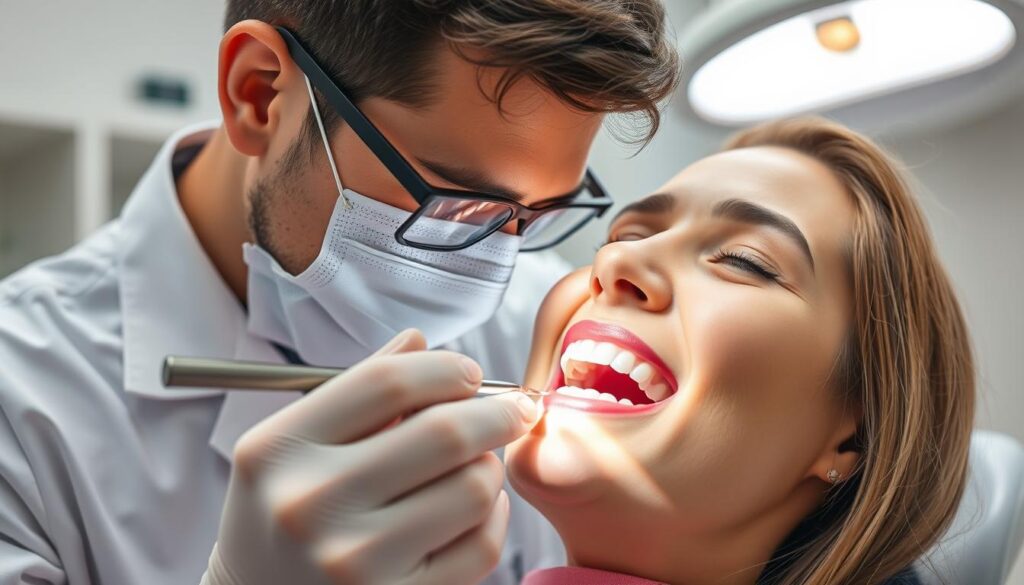
Don’t forget about regular cleanings as part of whitening your teeth. Cleanings tackle plaque and tartar, cutting down on stains. This boosts your whitening efforts and helps keep your smile bright. Your dentist will plan these cleanings to make your whitening even more effective and keep your teeth healthy.
- Consult your dentist about the best whitening options for you and any risks.
- Follow professional advice for care at home after whitening to keep up the results.
- Schedule regular dental cleanings for better oral health and a more beautiful smile from whitening.
Debunking Common Myths
There are many myths about dental care, especially about cleaning and whitening teeth. It’s important to know what’s true to keep your mouth healthy and have realistic hopes.
- Teeth Cleaning and Whitening: Some think that cleaning your teeth is the same as whitening them. But, cleaning only removes plaque and tartar. While this can make teeth look brighter by removing surface stains, it doesn’t change the tooth’s actual color like whitening treatments do.
- Over-the-Counter Products: The market offers many products that claim to whiten teeth. But, even though some can remove stains, they’re often not as good as professional treatments. They might not give the expected results in cleaning and whitening your teeth.
- Long-term Effects: Another myth is thinking the results from cleaning and whitening last forever. Both professional and DIY whitening need regular care and touch-ups to keep your teeth bright.
Consulting with dental experts is the best way to avoid these myths. They can give you facts based on science and their experience. This ensures the treatments work well and keep your mouth healthy.
Special Considerations for Individuals
When choosing whitening and dental cleanings, it’s important to consider each person’s unique situation. Age, tooth sensitivity, and dental work like fillings matter a lot. These factors shape the cleaning method used, making sure it’s both effective and safe for oral health.
Younger people usually have stronger teeth, letting dentists use more intense cleaning methods safely. But as we get older, our teeth can become more delicate. So, dentists use gentler ways to clean without causing harm, while still removing stains well.
Those with sensitive teeth need special care. They need dental cleanings that take their sensitivity into account. This ensures they’re comfortable while still getting their teeth properly cleaned. Thankfully, modern technology has made this easier, allowing for effective cleaning without pain.
For those with things like crowns, veneers, or fillings, a unique cleaning method is needed. The materials in these restorations react differently than natural teeth to cleaning agents. Dentists must use special techniques to clean these parts without damage, ensuring the whole smile looks good.
- The importance of adapting professional teeth cleaning techniques based on age to ensure both safety and effectiveness.
- How customized dental cleanings for stain removal can benefit individuals with sensitive teeth, using gentle techniques that relieve discomfort.
- The necessity of specific protocols for cleaning around and on restorative work to maintain integrity and aesthetics of the dental materials.
Talking to dental professionals who know these details can really change your dental care results. Getting treatments designed for your specific needs not only improves how your teeth look and feel. It also makes your dental visits more comfortable and worry-free.
Advances in Dental Technology
Dental care is growing fast, especially in teeth cleaning procedures and teeth cleaning and stain removal. These new methods are making treatments better and starting a big change in mouth care and beauty dentistry.
Innovations in Teeth Cleaning: New tech has started a new phase for teeth cleaning procedures. Now, laser dentistry and ultrasonic scaling make getting rid of plaque less painful and more effective. These new ways ensure a deep clean without hurting the teeth.
New Techniques for Stain Removal: We now have better polishing agents and tools for removing stains. This means we can get rid of stains and make teeth their natural color again. Technologies like optical abrasion help remove tough stains safely.
Prospective Future Trends: The future looks bright for teeth cleaning and stain removal with AI and machine learning coming into play. These could find problem areas early and make cleaning plans just for you, making cleaning even better.
The Psychological Impact of Smiling
A beautiful smile does more than look good. It greatly improves how we feel and how people see us. A great smile, from regular teeth cleaning for a brighter smile or dental cleaning for whitening, boosts our confidence. It changes our image in the eyes of others.
Keeping our smile bright is not just for health. It also improves our social and emotional well-being.
How we smile can change our life, affecting both personal and work relationships. Getting a brighter smile with dental cleaning for whitening makes us more confident. It also makes us smile more and enjoy a richer social life. Also, people see white and clean teeth as signs of trust and friendliness. This can open up new opportunities for us.
| Aspect | Impact of Whitened Teeth |
|---|---|
| Personal Confidence | Increases self-esteem and social interaction |
| Perception by Others | Enhances perceptions of professionalism and cleanliness |
| Relationship Building | Improves interpersonal relationships through positive first impressions |
Getting our teeth cleaned does more than keep them healthy. Teeth cleaning for a brighter smile helps us interact better. It makes us seem healthier, more energetic, and more attractive.
Regulatory and Safety Standards
Making sure dental procedures like teeth cleaning and whitening are safe and follow the rules is key for patient health. This part talks about the main safety steps and rules for professional teeth cleaning and whitening products.
Safety of Dental Procedures
Professional teeth cleaning and whitening have strict safety measures to keep patients safe. These treatments follow guidelines to stop infections and other problems. Dentists work hard to give top care during teeth cleaning and whitening.
Regulations on Whitening Products
Teeth whitening products must be both safe and work well, so there are strict rules. These rules reduce risks like gum problems or damaging the enamel. Every whitening product must meet these standards to be sold.
Importance of Choosing a Certified Professional
It’s important to get teeth cleaning and whitening done by certified pros. These dentists and hygienists have the training to do these treatments safely and follow the best practices.
Addressing Cost Concerns
It’s really important to know what you’re paying for with dental care. This includes looking at costs for teeth cleaning results and dental cleanings for stain removal. We’re here to help you manage those costs. Our guide will help you save money without losing out on quality.
Overview of Dental Insurance
Dental insurance plans can be very different. Some might cover all costs for teeth cleaning results, while others only cover part. It’s a good idea to check what your plan covers. This includes both regular and cosmetic procedures like dental cleanings for stain removal.
Budget-Friendly Teeth Whitening Options
Professional whitening is great but can be expensive. There are cheaper options like DIY kits or special toothpastes. Still, for the best teeth cleaning results, professional treatments are worth it. They cost more at first but are better in the long run.
Long-Term Benefits of Investing in Oral Care
Paying for professional dental care is more than just about looks. It’s about keeping your mouth healthy for life. Regular cleanings now can save you from costly treatments later. This means you’ll save money over time.
Conclusion: Cleanings and Teeth Whitening
In wrapping up the discussion on keeping teeth healthy and bright, having professional teeth cleaning regularly is key. These cleanings do a fine job in getting rid of surface stains. This makes your teeth look brighter. However, for significant color changes in teeth, teeth whitening treatments are the best choice.
When choosing how to keep your smile bright, know the perks of teeth cleaning. But also weigh the effectiveness of dental cleanings for stain removal against whitening procedures. Your lifestyle, what you eat, and your dental health influence this choice greatly.
Moreover, the value of regular dental check-ups should never be downplayed. These visits allow for deep cleaning, personalized advice on whitening, and early spotting of dental issues. By sticking to regular dental checks, you’re working towards a great smile and strong teeth health.


